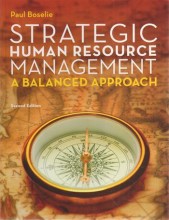Human Resource Management and Performance: Adding value through people/managment en prestaties - Introduction
14 important questions on Human Resource Management and Performance: Adding value through people/managment en prestaties - Introduction
Why are employees no resources?
How can you as HR influence performance?
2. Look ahead: by enhancing and saveguarding the employability of people
How can you balance system dynamics of the organization? (3)
As HR you can:
- Make the process smooth again by streamlining
- Improve employees' communication by co-operation
- improve the contributions of the performance of people by performing
- Higher grades + faster learning
- Never study anything twice
- 100% sure, 100% understanding
What is the difference between employability and workability and what four outcomes do they have in common?
Workability means if you are healthy enough to work.
The outcomes they have in common:
People who are employable and have a high workability show better performance, higher career success, higher productivity, less illness and more innovation creating value.
What does the management/employability paradox mean?
Employer: A professional organization having
- Relationships of authority with people
- Accessory responsibilities and obligations
What are the four steps of the HR value chain to develop critical success factors over time?
2. Determine the critical success factors that create competitive advantage. E.g. Innovation, productivity, high service quality.
3. Determine the employees attitude, behaviours, and cognitive factors that positively influence the critical success factors.
4. Determine HR practices that positively affect employees attitude and behaviour.
HRM managers can help the dynamics, not the process. Three things... (L.stavenuiter)
- Streamline - process making it smoother again
- Co-operate - will be able to improve their communication
- Perform - improving the contributions of the performance of people.
Note: lf you streamline, co-operate of perform as,a HRM manager then you arecontributing to the corporation. Because you are helping making it go smoother. To do this you must be available and accessible. Time-loss, people-loss and efficiency-loss costs value and money.
HRM managers can help the dynamics, not the process. Three things... (L.stavenuiter)
- Streamline - process making it smoother again
- Co-operate - will be able to improve their communication
- Perform - improving the contributions of the performance of people.
Note: lf you streamline, co-operate of perform as,a HRM manager then you arecontributing to the corporation. Because you are helping making it go smoother. To do this you must be available and accessible. Time-loss, people-loss and efficiency-loss costs value and money.
An organization continuity needs people to be employable:
- Good - products or services that you deliver needs to be good.
- Agile - everything changes so you need to work with the changes. Means you take the initiatives to make changes that are required.
- Flexible - be able to move with everything that happens and come back up again if you fall.
- Connected- you must know what is happening outside the company. Because there you see what is changing.
- Balanced - you must continuously balance of what you are working on.
- Healthy- financially, ethically, everything as a company needs to be healthy.
Internal resources VRIO
- valuable (economie condition)
- rare (scarcity)
- inimitable (hard to copy)
- non-substitutable (organisation) (no other resources that will meet the same ends).
o Financial: equity, debt or retained earnings.
o Physical: machines, factory, etc.
o Organizational: IT systems, management info systems.
o Human resources: knowledge, skills etc.
Next step link Boxall and Purcell's critical goals to HR outcomes...
- Distal outcomes
- Proximal outcomes
HR and performance debate is threefold:
2. A stream of HR research on the methods used to determine added value of HRM.
3. Recently overview and meta-analyses on HRM and performance were published.
- Overall there is a general agreement: HR practices are at least weakly related to firm performance. (these results should be treated with caution !)
The three types of HR practices
can be linked to three different employee groups:
professionals).
2. Actual HR practices (implemented mainly by line managers).
- Line managers are the ones enacting or implementing HR practices.
- Are thought to directly influence HRM outcomes.
The question on the page originate from the summary of the following study material:
- A unique study and practice tool
- Never study anything twice again
- Get the grades you hope for
- 100% sure, 100% understanding
































